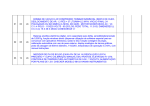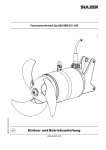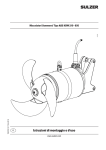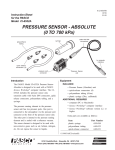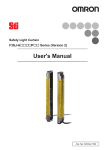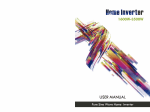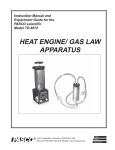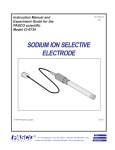Download PASCO Specialty & Mfg. CI-6534A User's Manual
Transcript
012-07034A 3/99 $1.00 Instruction Sheet for the PASCO Model CI-6534A and CI-6535 CI-6534A LOW PRESSURE SENSOR (0-10kPa) CI-6535 RESPIRATION RATE SENSOR cable with DIN connectors syringe P D 10 R R E k PA SS Y P S C UR AI a M C O E R O N A PA N PO O X R EC RT NL T T M Y N O A O R T . 6 : IN 40 G -0 21 polyurethane tubing quick release connectors (4) to computer interface 4A 53 -6 CI W RE LOSU R S O E S PR EN kPa) S 10 E G 0 - AU (G pressure port connector Introduction The PASCO Model CI-6534A Low Pressure Sensor (0-10kPa) is a pressure sensor that is designed to be used with a PASCO computer interface. This low pressure sensor is ideally suited for use with the PASCO Respiration Belt or the PASCO Heat Engine Apparatus. CI-6534A Low Pressure Sensor The low pressure sensor consists of the electronics box with a cable that has a DIN plug for connecting to a PASCO computer interface. The pressure sensor uses a 10 kiloPascal transducer. This type of transducer has two ports. The reference port of the transducer is inside the electronics box. It is always open to the atmosphere and not available to the user. The other port is connected to the atmosphere via the pressure port connector at the front of the pressure Pressure Sensor unit sensor unit. It has a “quick-release” style connector for attaching accessories such as the PASCO CI-6535 Respiration Belt accessory (which includes a Low Pressure Sensor). The pressure sensor gives a reading of “zero” when there is no pressure difference between the internal reference port and the external pressure port connector. The transducer is durable, but it is designed to be used with non corrosive gases such as air, helium, nitrogen, etc. Do not let the transducer get wet. The maximum short-term pressure that the sensor can tolerate without permanent damage is about 100 kPa (14 psi). Please be careful to not apply high pressure to the sensor. The electronics box contains a precision operational amplifier (op amp) that can drive a heavy capacitive © 1999 PASCO scientific Respiration Rate Sensor 012-07034A ADDITIONAL REQUIRED load, such as a six meter extender cable (CI-6515). There is a resistor in parallel with the transducer to compensate the sensor for temperature induced variations. The sensor has a negative temperature coefficient (resistance decreases as temperature increases) and the resistor has a positive temperature coefficient. • computer (PC or Macintosh) • Science Workshop® computer interface • Science Workshop® software version 2.2 or higher ADDITIONAL RECOMMENDED • Respiration Belt (PASCO part no. 003-05936, included in the CI-6535 Respiration Rate Sensor) • Heat Engine/Gas Law Apparatus (PASCO part no. TD-8572) Extra parts are available as follows: CI-6535 Respiration Rate Sensor The CI-6535 Respiration Rate Sensor consists of the CI-6534A Low Pressure Sensor and the PASCO Respiration Belt (003-05936). See Figure 1. PR DR10 ES kP PA SU Y SC CO RE AI a MA O NN R PA PO ON X RT EC RT LY TO NO MA R: . 640 TIN G -02 1 Item plastic syringe polyurethane tubing quick-release connector Respiration Belt Range and Resolution 4A 53 -6 CI W RE LOSU ES OR PR NSkPa) SE10 0- AU (G The range of the CI-6534A Low Pressure Sensor is between 0 and 10 kiloPascals. The resolution of the sensor is 0.005 kiloPascals (kPa) when used with a PASCO computer interface. The output voltage from the sensor is +1.00 Volts when the pressure is 1 kiloPascal (kPa), and the output voltage is linear. Therefore, the output voltage should be +10.00 Volts at the top of the range (10 kPa). Atmospheric pressure is normally around 101.326 kiloPascals (kPa). Pressure can be measured in many different units (e.g., atmospheres, inches of mercury, millimeters of mercury, kiloPascals, Bar, pounds per square inch). Some equivalent values for pressure are: GE Figure 1 Respiration Rate Sensor The belt has the following features: • hook-and-pile strips sewn onto opposite ends of the belt • attached squeeze bulb for inflating the rubber bladder inside the belt • quick-release connector that can be attached to the pressure port on the Low Pressure Sensor. 1 atmosphere = 30.00 in of Hg (at 16ºC) = 760 millimeters of Hg = 101.326 kiloPascals (kPa) = 1.013 Bar = 1013 milliBar = 14.696 pounds per square inch (psi) Equipment INCLUDED • • • • Part Number 699-084 640-023 640-021 003-05936 Low Pressure Sensor (Gauge) unit quick-release connectors (4) polyurethane tubing (0.6m) plastic syringe (20cc, calibrated) 2 012-07034A Respiration Rate Sensor Operation 5 1. Connect the Pressure Sensor unit to analog channel A, B, or C of the Science Workshop computer interface box using the cable with the DIN connectors (Figure 2). Alternatively, the unit can be plugged directly into the analog channel jack. tip 10 quick release connector Setting up the Equipment barb tubing Figure 3 Using the syringe To connect the syringe to the sensor, cut a short length of tubing (about one inch). Put the “barb” end of one of the quick-release connectors into one end of the short piece of tubing. Put the other end of the tubing over the tip on the end of the syringe. Note: You can lubricate the end of the barb to make it easier to put into the short piece of tubing. Put a very small amount of silicon oil or saliva onto the barb and then wipe the barb with a cloth so there is only a thin layer of lubricant on the barb. Align the quick-release connector with the pressure port connector of the sensor. Push the connector onto the port, and then turn the connector clockwise until it “clicks” into place (less than one-eighth of a turn). The barb of the quick-release connector is free to rotate even when the connector is firmly attached to the port. See Figure 4. N U 0 (GA-10 SOR RE UG kPa E) I-6 534 PR L A SE ESSOW C ES Y AI MAX SU R PA CORE PO ON SC NN RT LY O PA EC MA RT TOR: TIN NO G . 64 0-0 21 PR 10 DR kPa Figure 2 Connecting the amplifier box to the interface box 2. Connect the quick release connector to the pressure port connector on the Pressure Sensor unit. The sensor is temperature compensated, therefore changes in room temperature will not interfere with the data. quick release connector Push the connector onto the pressure port. Turn the connector clockwise until it “clicks” (less than 1/8 turn). Using the Syringe and Quick-Release Connectors The Pressure Sensor is designed for experiments such as those that study the gas laws or for the rate of a chemical reaction by monitoring the increase or decrease in pressure. For example, Boyle’s Law is a classic physics (and chemistry) concept that can be demonstrated using the sensor and the syringe. See Figure 3. pressure port connector Figure 4 Using the quick release connectors 3 tubing Respiration Rate Sensor 012-07034A Mounting on an Experimental Apparatus Use the 1/4-20 threaded connector located on the bottom of the sensor box to secure the Pressure Sensor to an experimental apparatus (Figure 5). The alignment hole fits over an alignment pin included on some PASCO apparatuses. alignment hole 1/4-20 threaded connector Figure 5 Mounting connector and alignment hole Using the Respiration Belt To measure respiration rate (breaths per minute), place the respiration belt around your chest or upper abdomen, connect one tube from the belt to the low pressure sensor, inflate the respiration belt with the squeeze bulb, and monitor the respiration rate with the computer interface. Figure 6 Connecting the Respiration Belt, Right Side First Placing the Respiration Belt Inflating the Respiration Belt Arrange the belt around your body so the part of the belt that has the tubes on it is on the right side of your body with the tubes hanging down from the bottom edge of the belt. Turn the knurled knob that is on the squeeze bulb fully clockwise to close the release valve. Squeeze the bulb several times to inflate the rubber bladder. You may have to squeeze the bulb more than twenty times in order to inflate the bladder. When the bladder is inflated, the belt will be more snug against your chest. Place the part of the belt that has the tubes against your chest first. When this part is against your chest, the strips of ‘pile’ should face away from your chest. Then place the left side of the belt over the first part so the hook-and-pile strips match each other. The belt should be snug around the chest, but not so tight that breathing is restricted. See Figure’s 6 and 7. Warning: Over inflation can damage the air bladder. Deflating the Respiration Belt Turn the knurled knob on the squeeze belt counterclockwise to open the release valve. Use your hands to push the air out of the bladder. You can also deflate the respiration belt by disconnecting the tube from the pressure port on the sensor. Turn the quickrelease connector counterclockwise to disconnect it from the pressure port. Connecting the Belt to the Sensor Align the quick-release connector on the end of one of the respiration belt’s tubes with the pressure port connector at the front of the pressure sensor unit. 4 012-07034A Respiration Rate Sensor Larger lung capacity and generally good health would tend to decrease respiration rate. Gay-Lussac’s Law (pressure vs. absolute temperature) Gay-Lussac’s Law states that if the volume remains constant, the pressure of a container of gas is directly proportional to its absolute temperature. Set up a sealed container of air by attaching the longer piece of plastic tubing to a stopper in a 125 mL Erlenmeyer flask. Put a drop of glycerin on the bottom of one hole of a two-hole rubber stopper. Put the glass part of an eyedropper tip end up through one hole in the rubber stopper. CAREFULLY put the end of the plastic tubing over the tip of the eyedropper. Connect the other end of the tube to the pressure port connector at the front of the pressure sensor unit.. Put a drop of glycerin on the top of the other hole. Insert a temperature sensor through the hole. Place the stopper in the top of the flask. See Figure 8. Figure 7 Respiration Belt In Place Lift up on the top flap of the respiration belt to disengage the hook-and-pile strips from each other when you want to remove the belt. Figure 8 Experiment Setup For Gay-Lussac’s Law Suggested Experiments Respiration Rate versus Activity Place the flask in water baths of different temperatures. Record data on how the pressure changes with the temperature changes. Monitor respiration rate before and after exercise. Measure the respiration rate while resting. Then exercise vigorously. Measure the respiration rate immediately after exercise, and the measure how long it takes for the respiration rate to return to the resting (“normal”) rate. Pressure in Liquids Put the end of the longer piece of tubing under water. The pressure reading should increase by 0.0978 kPa (0.02896 in of mercury) per centimeter of depth below the surface. You can also use a “J” shaped tube to study how pressure relates to the difference in heights of the liquid in the two parts of the tube. Respiration rate (number of breaths per unit of time) depends on several factors: altitude, lung capacity, health, and level of activity. Higher altitudes and levels of activity would tend to increase respiration rate. 5 Respiration Rate Sensor 012-07034A Studying Chemical Reactions by Monitoring Pressure DIN Connector Specifications Many chemical reactions produce gases that can cause an increase in pressure in a sealed container. The pressure change can be used to monitor the rate of the reaction. 2: analog output (-), signal ground 1: analog output (+), -10 to +10 V 3: (no connection) 6: +12 VDC power Other 7: -12 VDC power PASCO scientific also produces an Absolute Pressure Sensor (Model CI-6532A), a Differential Pressure Sensor (Model CI-6533) and a Barometer (Model CI6531A). The Absolute Pressure Sensor has a range from 0 to 700 kiloPascals. The Differential Pressure Sensor is similar to the CI-6532A, except that both ports of the transducer are open to the atmosphere. It is designed for experiments where pressure differs from one part of the apparatus to another, such as in a Venturi tube or for a demonstration of Bernoulli’s principle. The Barometer has a range from 800 to 1100 milliBar (24 to 32 inches of mercury). It is designed to be a reliable, accurate pressure sensor for weather studies. It is temperature compensated and has a voltage regulator, so changes in temperature or changes in the computer’s power supply will not interfere with the data. 6 1 8 1 5: power ground P D 0 R R E k PA SS Y P S C UR AI a M C O ON E R A PA N PO O X R EC RT NL T T M Y N O A O R T . 6 : IN 40 G -0 21 4: + 5 V DC power 7 3 5 4 2 8: (no connection) Limited Warranty PASCO scientific warrants the product to be free from defects in materials and workmanship for a period of one year from the date of shipment to the customer. PASCO will repair or replace, at its option, any part of the product which is deemed to be defective in material or workmanship. The warranty does not cover damage to the product caused by abuse or improper use. Determination of whether a product failure is the result of a manufacturing defect or improper use by the customer shall be made solely by PASCO scientific. Responsibility for the return of equipment for warranty repair belongs to the customer. Equipment must be properly packed to prevent damage and shipped postage or freight prepaid. (Damage caused by improper packing of the equipment for return shipment will not be covered by the warranty.) Shipping costs for returning the equipment after repair will be paid by PASCO scientific. Note: This instruction sheet was written assuming that the user has a basic familiarity with Science Workshop and has access to the User’s Guide for Science Workshop. Users can gain basic skills by working through the tutorial within Science Workshop. Another useful resource is the Quick Reference Card for Science Workshop. Address: Phone: FAX: email: web: 6 PASCO scientific 10101 Foothills Blvd. Roseville, CA 95747-7100 (916) 786-3800 (916) 786-8905 [email protected] www.pasco.com







